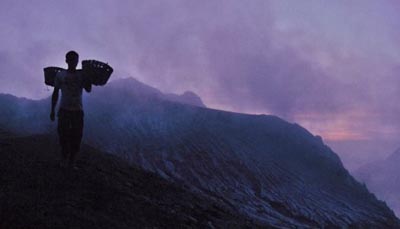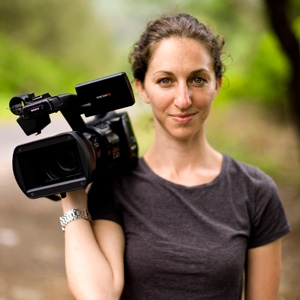 From emerging filmmaker Sasha Friedlander comes that rare documentary film managing to combine cinematic savvy, memorable subjects, and jaw-dropping visuals. Where Heaven Meets Hell—sure to be the hot ticket at this year’s Pacific Rim Film Festival—follows the treacherous livelihoods of four young Indonesians who work the toxic terrain of sulfur mining. Six months of filming has produced an indelible document of hope and heartbreak.
From emerging filmmaker Sasha Friedlander comes that rare documentary film managing to combine cinematic savvy, memorable subjects, and jaw-dropping visuals. Where Heaven Meets Hell—sure to be the hot ticket at this year’s Pacific Rim Film Festival—follows the treacherous livelihoods of four young Indonesians who work the toxic terrain of sulfur mining. Six months of filming has produced an indelible document of hope and heartbreak.
For those familiar with documentary work that manages to merge photographic grandeur with social consciousness—Ed Burtynsky and Werner Herzog are two giants of this difficult screen genre—Friedlander’s sensitive filmmaking instincts will prove as familiar as they are adroit. Achieving that most difficult mix of empathy for her subjects with confident narrative skills, Friedlander fuses her compassion with her talent. The effect is hauntingly beautiful.
As Herzog managed in his spectacular vision of the burning Kuwaiti oil fields—Lessons Of Darkness—Friedlander insists upon the visual glories of saffron-hued sulfuric clouds roiling up from the depths of a Javanese hell. Grabbing our attention, she focuses on the individual lives of four men who barely manage to feed their families with work so backbreaking that it hurts to watch. Hauling in each trip more than their own weight in raw sulfur, up torturous rocky paths they emerge three miles later at the refining station. There the sulfur is processed for use in sugar, cosmetics and rubber production. The sight of these slender men groaning under staggering loads of brilliant yellow ore is wrenching. It is also frankly sobering to those of us who grew up in worlds of comfort, fair wages, and good dentistry.
It’s hard to know which of Friedlander’s filmmaking skills shines brightest in Where Heaven Meets Hell. As director, she smartly interweaves the compelling stories of each subject with the gradual revelation of the sulfur extraction process, from digging, to hauling, to meager pay day. We meet the wives and small children, who live in villages away from the volcano, in arduous poverty deep within lush emerald forests. The men gradually tell their dreams—dreams of being able to get jobs that won’t destroy their lungs. Dreams of buying clothes for their wives, and most of all the dream of an education, for themselves and for their children.
The filmmaker wisely allows her subjects to tell their own stories, and as cinematographer Friedlander carries her camera low enough for an intimate examination of everyday life. Sulfur swirling through the fumes of the mines coats the men’s eyelashes with a grotesque yellow “mascara.” Bare feet move across dirt floors, as kitchen fires are stoked and rice is stirred. Her editing unerringly interweaves, delicately dissects and then re-knits the pace of days spent in toxic heat, weekends enjoyed in verdant villages, and job quests undertaken in the harsh neon glare of contemporary Indonesian cities.
 Friedlander, fluent in Indonesian languages, is firmly yet not cloyingly engaged with her subjects. They emerge gradually and compellingly as her film unfolds, as a likeable and earnest group. The subtext of education as a cruel and defining lack, emerges more subtly. No need to be aggressively didactic, ala Michael Moore, this filmmaker seems to be saying. Here the astonishing images say more than any script or agenda could do.
Friedlander, fluent in Indonesian languages, is firmly yet not cloyingly engaged with her subjects. They emerge gradually and compellingly as her film unfolds, as a likeable and earnest group. The subtext of education as a cruel and defining lack, emerges more subtly. No need to be aggressively didactic, ala Michael Moore, this filmmaker seems to be saying. Here the astonishing images say more than any script or agenda could do.
Friedlander’s highly accomplished 80 minute odyssey has already attracted worldwide attention, and was most recently named Best Documentary at the Hawaiian International Film Festival. Where Heaven Meets Hell will also be one of three films highlighted by Amnesty International at the IDFA Festival in Amsterdam next month.
Where Heaven Meets Hell will screen at the Cabrillo College Crocker Theatere, Tuesday, October 23, at 8:15. Q&A with director Sasha Friedlander follows the film. Get in line early and prepare to be riveted.


Having been fortunate to have seen a private viewing of the final cut last year, and then being among the NY Film Fest audience at Lincoln Center, this is an important film and our columnist Christina Waters’ review is splendid! Here is a little window into how important films impact society, I was accompanied by a friend to the screening, and the next day she told her 10 year old daughter about where she went and the film she saw, as she was walking her daughter to the bus stop this morning, her 10 yr-old daughter is telling her 10 yr-old friend about sulfur miners somewhere in Java………..as insignificant that moment may seem, it is a vapor trail from this little rocket ship of a film maker! Important films don’t just happen and appear, they are created by important film makers. An awesome and brilliant accomplishment, my heartiest congratulations!
Another well-off “artiste” playing anthropologist with a camera. Did she mention the names of the bond holders and international bankers who financed the mining operations, and their “skim” which keeps livings so sparse for the miners? Or was this just another video expiation of liberal guilt over being a beneficiary of this exploitation?
Those miners wanted an “education” you say? Yes, so their positions would be filled by others, not them. “Education” is merely training that changes the names of the exploited. The real problem is not addressed, or even mentioned by “education”.
The film explores the duplicity of the mine owners, but spend most of its time allowing the miners to voice their personal dreams and ambitions.
You bring up an excellent point however, re: “education” being all too often a revolving door in which the newly educated move up in the hierarchy, only to find the lowest rungs immediately filled up again with the nouveau exploited.
It is the system of exploitation itself that needs dismantling. Marx pointed the way. But between his theory and the opportunistic “practice” a huge chasm has formed that no one seems capable of eradicating.
Hobbes was right – the only thing that moves people to action is enlightened self-interest, i.e. what’s in it for me?
Thanks for the comment.
C
Sorry Christina, but the only “way” that Marx showed was the way to hell.
His interpretation of the “problem” and its “solution” was a creature of a materialistic worldview which emanated from so-called “enlightenment” thinking, emslaved to a worldview addicted to “progress”.
A universalist worldview based on abstract concepts of “classes” in conflict, was and still is profoundly destructive of any organic traditions of A People, and how people really live as they are “thrown into” the world of a particular people in a particular place and time. Being is always DAsein, rather than an academic abstraction.
The Marxian heresy against real Peoples pervades currently fashionable academic discourses, and that’s not benefitted real peoples one bit. Freeing up real peoples to be themselves unto and for themselves would utterly destroy supremacist materialist discourses which are the daily bread and butter of so-called “higher education” … an enterprise which is itself a bigger part of the problem than any solution.
:)